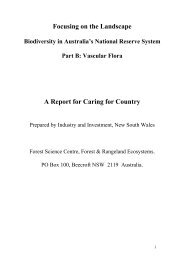Biodiversity in Australia's National Reserve System - Part ... - BushBlitz
Biodiversity in Australia's National Reserve System - Part ... - BushBlitz
Biodiversity in Australia's National Reserve System - Part ... - BushBlitz
Create successful ePaper yourself
Turn your PDF publications into a flip-book with our unique Google optimized e-Paper software.
The f<strong>in</strong>d<strong>in</strong>gs of the studies of species be<strong>in</strong>g found <strong>in</strong> large or small numbers of reserves<br />
provide simple results. Species present <strong>in</strong> larger numbers of reserves <strong>in</strong> the NRS are those<br />
that are mobile and/or have large ranges. Hence, they are present <strong>in</strong> or able to easily move<br />
through large areas of land and be present <strong>in</strong> many reserves. Birds and bats are very good<br />
examples, hav<strong>in</strong>g larger numbers of species <strong>in</strong> many reserves because they move over large<br />
areas. On the other hand, the <strong>in</strong>vertebrates provide the major numbers or species present <strong>in</strong><br />
very few reserves. Many species have very small ranges and the non-fly<strong>in</strong>g terrestrial<br />
species are relatively immobile. Hence, they are not likely to cover large areas and so can<br />
not be present with<strong>in</strong> larger numbers of reserves. Many land snails have very small<br />
distributional ranges, hav<strong>in</strong>g evolved <strong>in</strong> specific rocky ranges and so will never be<br />
represented <strong>in</strong> many reserves. However, they can be highly reserved if their limited area of<br />
habitat is protected.<br />
One of the encourag<strong>in</strong>g results of this study was that nearly all species of all 11 studied<br />
groups are found <strong>in</strong> more than one protected area and that, where a species is found <strong>in</strong> only a<br />
very few protected areas, these are generally areas greater than 1000 ha <strong>in</strong> size. Larger areas<br />
are less prone to edge effects and will usually conta<strong>in</strong> a greater diversity of sites and larger<br />
populations, mak<strong>in</strong>g these populations more robust to stochastic events and have larger<br />
genetic pools for evolutionary development. One thousand hectares was chosen as the cutoff<br />
size for a larger reserve based on its use for the same purpose by Rodrigues et al 2004.<br />
They used this as a m<strong>in</strong>imum effective size for a reserve for a number of taxa. It is not<br />
specifically clear that 1000 ha is a suitable size to ma<strong>in</strong>ta<strong>in</strong> any specific population over the<br />
long-term, but such an area seems likely to provide a significant area of habitat for smaller,<br />
relatively immobile species, allow<strong>in</strong>g them to ma<strong>in</strong>ta<strong>in</strong> relatively large numbers of<br />
<strong>in</strong>dividuals. Smaller areas have been found to ma<strong>in</strong>ta<strong>in</strong> populations with<strong>in</strong> fragmented<br />
landscapes with Dr<strong>in</strong>nan (2005) f<strong>in</strong>d<strong>in</strong>g 3.5 ha to be a useful reserve size threshold and, more<br />
importantly, patches greater than 50 ha were able to ma<strong>in</strong>ta<strong>in</strong> forest <strong>in</strong>terior species and<br />
species that were sensitive to human disturbances. Tocher et al (1997) also found no obvious<br />
loss of frogs <strong>in</strong> fragments much smaller than 1000 ha. This suggests that 1000 ha is likely to<br />
provide a substantial area of habitat <strong>in</strong> which to conserve populations of any of the terrestrial<br />
<strong>in</strong>vertebrates and the smaller terrestrial vertebrates. They are not necessarily sufficiently<br />
large for species that fly or the more mobile vertebrates. Furthermore, we po<strong>in</strong>t out that<br />
fragmentation of the rema<strong>in</strong><strong>in</strong>g native vegetation through land clear<strong>in</strong>g rema<strong>in</strong>s a serious<br />
threat as it will isolate even larger areas of reta<strong>in</strong>ed land and can render 1000 ha or larger<br />
reserves of little value for all but the smallest species over the very long term.<br />
191






